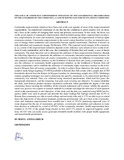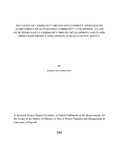| dc.description.abstract | Community empowerment initiatives have been seen at the core agendas of most of the nongovernmental organizations. An empowered community is one that has the conditions to given mastery over its member‟s lives in the context of changing their social and polit-ical environment. In this study, the focus was on the social aspects of community em-powerment which included among others, empowerment on education, empowerment on water and sanitation, empowerment on health and empowerment of human rights aware-ness creation. Community empowerment in the social context therefore involves an inter-active process of change where institutions and communities become equally trans-formed. Therefore it focuses on both individual and community change (Wallerstein 1992). The expected social changes in the community as a result of the empowerment ini-tiatives depends on the influence such initiatives have on the livelihood of such commu-nities and in this case, the community of Kisumu East sub county, a case of buoye com-munity. The study therefore sort to determine the influence of these empowerment initia-tives through the following objectives; to determine the influence of community educa-tion empowerment initiative on the livelihood of the Kisumu East sub county communi-ties, to examine the influence of community water and sanitation empowerment initiative on the livelihood of Kisumu East sub county communities, to assess the influence of community health empowerment initiative on the livelihood of Kisumu East sub county communities and to establish the influence of community rights awareness creation on the livelihood of Kisumu East sub county communities . In order to achieve these objec-tives, the study used a descriptive study design targeting 115,502 households in Kisumu East Sub county with a sample size of 384 households derived from the Krejcie & Mor-gan formulae for determining sample size (1970). Multistage random sampling technique was used to determine the specific community to be interviewed and Buoye community was selected. Data was collected using structured questionnaire which had five parts; the background information, and the remaining four parts each covering one objective. To ensure reliability the study used Pearson product-moment correlation coefficient which quantified the degree of the data consistency hence ensuring the reliability of the re-search instrument and to ensure validity the questionnaires was given to two experts in research methods to evaluate and judge the relevance of each question asked in the ques-tionnaire to the objectives of this study and the data was analyzed using SPSS and fre-quency tables were used to present and describe the study findings.The findings showed that 62.5% of Kisumu East community are able to reach college and university with only 4.17% not able to go to school hence the high levels of educational standards, producing professionals who give back to the community, water and sanitation empowerment have resulted into a total of 79.43% practicing improved ways of waste disposal like the use of incinerators, pit latrines, covered pits and dustbins and reduction in water born diseas-es as indicated by a total of 69.54%, of the community members, health empowerment have resulted in 43.23% of the people being trained on first aid,57.3% trained on im-proved hygienic conditions, 64.32% who can easily access good and affordable health fa-cilities with proper health equipments and trained health practitioners | en_US |





